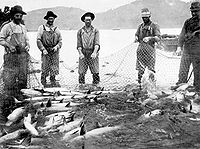Pacific Salmon Commission
| File:Pacific Salmon Commission (logo).jpg | |
| Abbreviation | PSC |
|---|---|
| Formation | 1937 |
| Headquarters | Vancouver, British Columbia |
| Location |
|
Region served | Canada and the United States |
Chair | Susan Farlinger |
| Website | http://www.psc.org/index.htm |
The Pacific Salmon Commission is a regulatory body run jointly by the Canadian and United States governments. Its mandate is to protect stocks of the five species of Pacific salmon. Its precursor was the International Pacific Salmon Fisheries Commission, which operated from 1937 to 1985. The PSC enforces the Pacific Salmon Treaty, ratified by Canada and the U.S. in 1985.[1]
Origins


The first commercial salmon fisheries in the Pacific Northwest were started in the early 1800s. Lucrative fisheries were established on the Columbia and Fraser rivers, including canneries geared for export. Harvests increased year-to-year until the 1910s. The abundance of the resource had precluded any disagreements between the Canadian and American governments until this point.[2]
However, from the 1920s onward, stocks began to decline, a result of over-fishing and the degradation and obstruction of migratory rivers. Competition between American and Canadian fisheries for the dwindling resource led to conflict. Disputes were complicated by the fact that the salmon crossed several international borders during their lifespan. In 1930, the governments met and proposed the Fraser River Convention to regulate fishing and mitigate environmental damage to salmon habitats. The International Pacific Salmon Fisheries Commission was formally founded in 1937.[3]
IPSFC
The early focus of the IPSFC was to restore the Fraser runs of sockeye salmon. Three obstacles were identified - the Hells Gate portion of the Fraser Canyon (where a landslide in 1913 caused by railway engineers had partially blocked the river), the Quesnel River splash dam, and the Adams River splash dam. During the 1940s, fish ladders and spillways were constructed by the Commission at Hell's Gate. The splash dams on the Quesnel and Adams were dynamited and removed.[2]
Pacific Salmon Treaty
By the 1970s, cooperation between the two governments in setting fishing quotas had faltered. In 1982, a comprehensive treaty was signed and was fully ratified in 1985.[4] It limited catches of Alaska, Fraser, and Columbia salmon to pre-set quotas and committed the governments to improving the spawning capacities of the region's rivers. The treaty was amended in 1999.[3]
Structure
The PSC is divided into three panels. The Northern Panel covers Alaska and northern British Columbia stocks. The Fraser River Panel covers the Fraser, while the Southern Panel is responsible for the Columbia and other U.S. stocks. Each panel monitors harvesting, spawning, and habitat quality in its respective region, then makes recommendations to the Commission. These recommendations determine seasonal fishing quotas and openings.[3]
References
- ^ Lane, E.D.; W. Pennell (2011). "Pacific Salmon". The Canadian Encyclopedia. Retrieved 3 February 2011.
- ^ a b Roos, John F. (1991). Restoring Fraser River salmon : a history of the International Pacific Salmon Fisheries Commission, 1937-1985. Vancouver: Pacific Salmon Commission. pp. 10–13, 14–17. ISBN 0-9694947-0-X.
- ^ a b c Miller, Kathleen A. "North American Pacific Salmon: A Case of Fragile Cooperation". United Nations Fisheries and Aquaculture Organisation. Retrieved 4 February 2011.
- ^ Harrison, John (2010). "Pacific Salmon Treaty". Columbia River History. Northwest Power and Conservation Council. Retrieved 4 February 2011.

